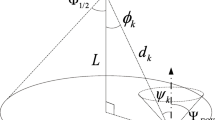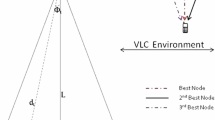Abstract
Visible light communication (VLC) has been a promising field of optical communications which focuses on visible light spectrum that humans can see. Unlike existing studies which mainly discuss point-to-point communication, in this paper, we consider a VLC network, in particular a \(2 \times 2\) system. Our focus is on dealing with interference in this network. The objective is to maximize the signal to interference plus noise ratio (SINR) of one receiver for a given SINR of another receiver. We formulate a power allocation optimization problem to deal with such interference, and introduce dichotomy to solve this optimization problem. Simulation results have twofold meaning: First, \(\mathrm{SINR}_1\) increases with the growth of \(\mathrm{SINR}_2\), which are the SINR of the two receivers, respectively. Second, our proposed scheme outperforms the classical time-division multiple access technique in terms of transmit powers of both light sources when the data rate for these two schemes are set to be identical for each user, respectively.






Similar content being viewed by others
References
Elgala, H., Melsleh, R., Haas, H.: Indoor optical wireless communication: potential and state-of-the-art. IEEE Commun. Mag. 49(9), 56–62 (2011)
Chen, S.-H., Chow, C.-W.: Single-input multiple-output visible light optical wireless communications supporting quality of service. Electron. Lett. 51(5), 406–408 (2015)
Chi, N., Haas, H., Kavehrad, M., Little, T.D.C., Huang, X.-L.: Visible light communications: demand factors, benefits and opportunities [Guest Editorial]. IEEE Wireless Commun. 22(2), 5–7 (2015)
Burton, A., Ghassemlooy, Z., Rajbhandari, S., Liaw, S.-K.: Design and analysis of an angular-segmented full-mobility visible light communications receiver. Trans. Emerg. Telecommun. Technol. 25(6), 591–599 (2014)
Arnon, S., Barry, J., Karagiannidis, G., Schober, R., Uysal, M.: Advanced Optical Wireless Communication Systems. Cambridge Univ. Press, Cambridge (2012)
Komine, T., Nakagawa, M.: Fundamental analysis for visible-light communication system using LED lights. IEEE Trans. Consum. Electron. 50, 100–107 (2004)
Zeng, L., et al.: High data rate multiple input multiple output (MIMO) optical wireless communications using white LED lighting. IEEE J. Sel. Areas Commun. 27(9), 1654–1662 (2009)
Tsonev, D., Sinanovic, S., Haas, H.: Practical MIMO capacity for indoor optical wireless communication with white LEDs. In: Proceeding of IEEE VTCSpring, pp 1–5 (2013)
Tran, N.-A., Luong, D.A., Thang, T.C., Pham, A.T.: Performance analysis of indoor MIMO visible light communication systems. In: Communications and Electronics (ICCE), 2014 IEEE 5th International Conference on, Danang, pp 60–64 (2014)
Fath, T., Haas, H.: Performance comparison of MIMO techniques for optical wireless communications in indoor environments. IEEE Trans. Commun. 61(2), 733–742 (2013)
Nuwanpriya, A., Ho, S.-W., Chen, C.S.: Indoor MIMO visible light communications: novel angle diversity receivers for mobile users. In: IEEE JSAC (2015)
Kahn, J.M., Barry, J.R.: Wireless infrared communications. Proc. IEEE 85(2), 265–298 (1997)
Author information
Authors and Affiliations
Corresponding author
Additional information
This work was supported by the National Natural Science Foundation of China under Grant (61301182, 61171071, 61575126), supported in part by the Postdoctoral Science Foundation of China under Grant 2015M572358, by the Specialized Research Fund for the Doctoral Program of Higher Education from the Ministry of Education of China under Grant 20134408120004, by the Natural Science Foundation of Guangdong Province under Grant (S2013040016857, 2015A030313552), by Yumiao Engineering from the Education Department of Guangdong Province under Grant 2013LYM_0077, by the Key Project of Department of Education of Guangdong Province under Grant 2015KTSCX121, by the Open Fund from The State Key Laboratory of Integrated Services Networks Xidian University under Grant ISN15-06, by the Foundation of Shenzhen City under Grant (KQCX20140509172609163, GJHS20120621143440025, JCYJ20140418095735590), by Natural Science Foundation of SZU under Grants 00002501 and 00036107.
Rights and permissions
About this article
Cite this article
Dai, M., Yuan, J., Feng, R. et al. A power allocation method for \(2 \times 2\) VLC-MIMO indoor communication. Opt Rev 23, 678–682 (2016). https://doi.org/10.1007/s10043-016-0232-8
Received:
Accepted:
Published:
Issue Date:
DOI: https://doi.org/10.1007/s10043-016-0232-8




